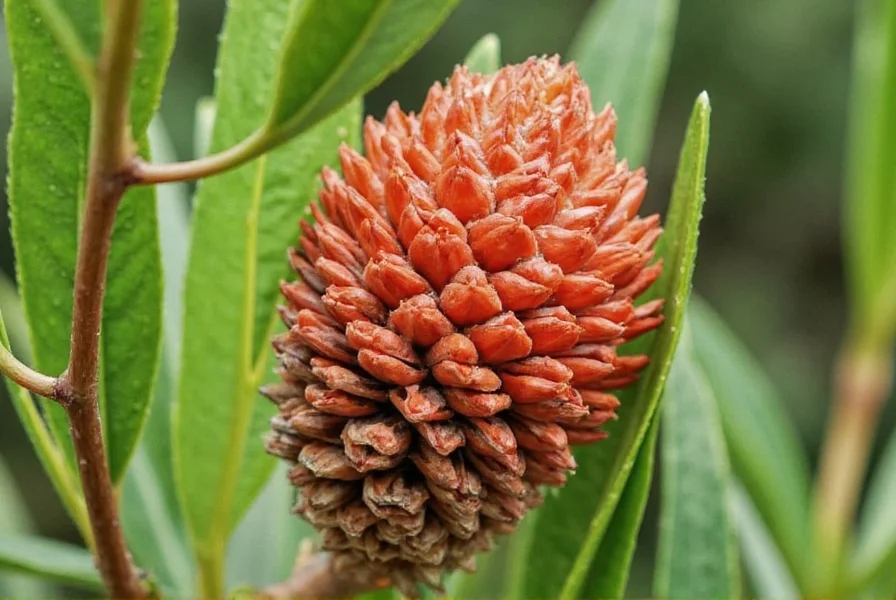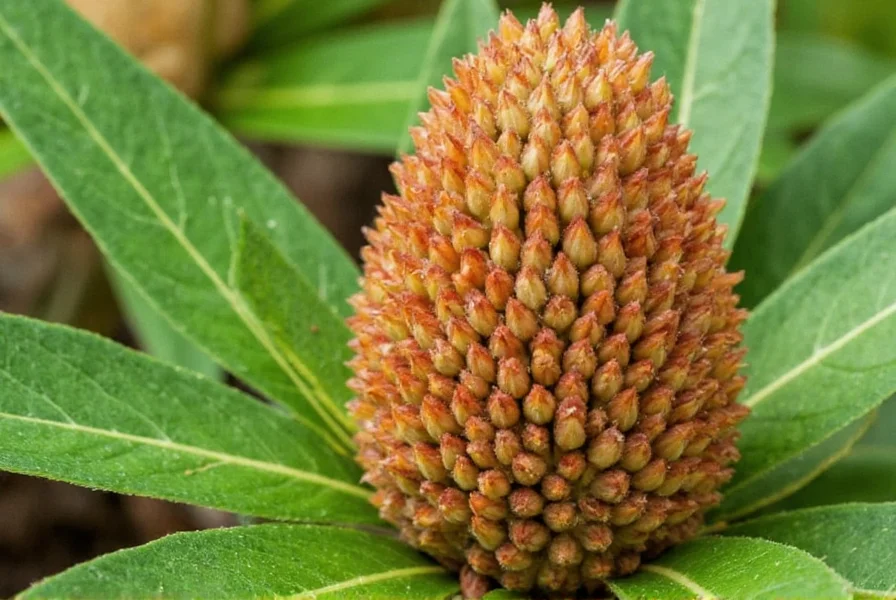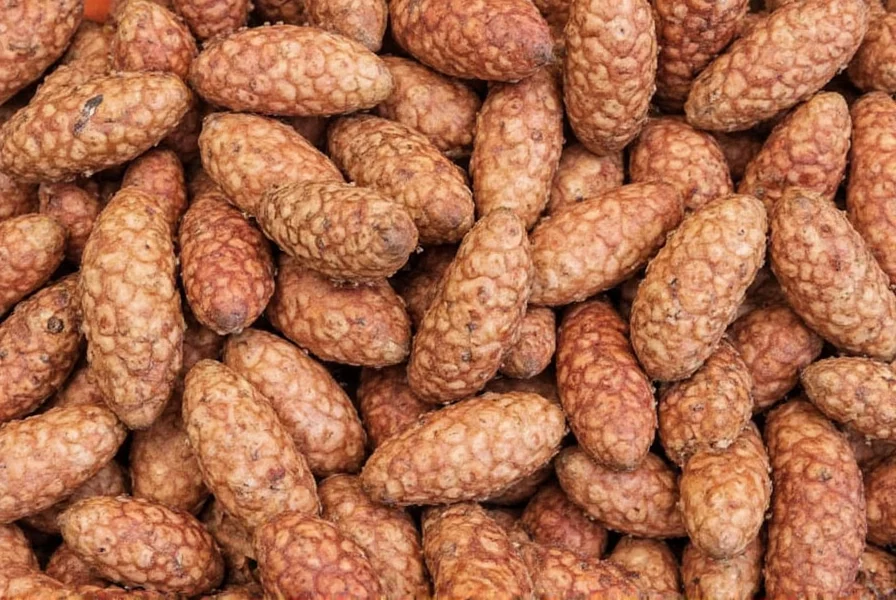Often confused with regular ginger due to its name, pine cone ginger (Zingiber zerumbet) belongs to the Zingiberaceae family but serves different purposes in gardens and traditional medicine. This striking plant produces unique cone-shaped flower structures that start green, mature to reddish-brown, and eventually release a fragrant, clear liquid when squeezed—earning it nicknames like shampoo ginger or shampoo root.
Botanical Identity and Naming Confusion
Despite its common name, pine cone ginger has no relation to pine trees. The "pine cone" descriptor refers solely to the appearance of its inflorescence. Scientifically classified as Zingiber zerumbet, this plant is sometimes mistakenly called Zingiber zerumbet var. aromaticum in horticultural circles. It's crucial to distinguish this species from culinary ginger (Zingiber officinale), which belongs to the same family but produces the familiar rhizome used in cooking.
Physical Characteristics
Pine cone ginger displays several distinctive features that help with identification:
| Feature | Description |
|---|---|
| Height | 3-5 feet tall at maturity |
| Leaves | Long, lance-shaped, bright green (12-24 inches) |
| Inflorescence | Cone-shaped, 2-4 inches long, green turning to reddish-brown |
| Rhizome | Thick, knobby, pale yellow with pink tips |
| Flowering Season | Summer through fall in tropical climates |
The plant's most remarkable characteristic is its inflorescence, which initially appears as a tight green cone emerging from the ground. As it matures, the cone turns reddish-brown and begins to exude a clear, fragrant liquid with a citrus-pine aroma when gently squeezed—hence the "shampoo ginger" moniker.

Natural Habitat and Distribution
Zingiber zerumbet is native to Southeast Asia, particularly thriving in the tropical rainforests of India, Malaysia, and Indonesia. It has naturalized in many tropical regions worldwide, including Hawaii, where it's commonly found in moist, shaded areas. Unlike culinary ginger, which requires specific cultivation conditions, pine cone ginger adapts well to various tropical and subtropical environments, often growing wild along stream banks and forest edges.
Growing Requirements for Gardeners
Successfully cultivating pine cone ginger requires attention to specific environmental factors:
Climate and Hardiness
This tropical perennial thrives in USDA hardiness zones 8-11. In zone 8, it may die back during winter but typically returns in spring. Gardeners in cooler climates can grow it as a container plant, bringing it indoors before first frost.
Light Requirements
While pine cone ginger tolerates full sun in consistently moist environments, it performs best in partial shade—receiving 2-4 hours of morning sun with protection from intense afternoon rays. In its natural habitat, it grows beneath forest canopies, making dappled light ideal for optimal growth.
Soil and Water Needs
For healthy growth, pine cone ginger requires:
- Rich, loamy soil with excellent drainage
- pH between 5.5 and 6.5 (slightly acidic)
- Consistent moisture without waterlogging
- Regular watering during dry periods
Mulching helps maintain soil moisture and temperature stability. During active growth (spring through fall), water when the top inch of soil feels dry. Reduce watering in winter when growth slows.
Planting and Propagation Techniques
The most reliable method for establishing pine cone ginger is through rhizome division:
- Obtain healthy rhizomes with visible growth buds ("eyes")
- Plant in spring after last frost, 2-4 inches deep
- Space rhizomes 12-18 inches apart
- Water thoroughly after planting
- Maintain soil temperature above 70°F (21°C) for optimal sprouting
Rhizomes typically sprout within 3-6 weeks. For container growing, use a pot at least 12 inches in diameter with drainage holes. A mix of potting soil, perlite, and compost provides ideal growing conditions.
Uses of Pine Cone Ginger
Unlike culinary ginger, pine cone ginger has limited use in cooking due to its bitter taste. However, it serves several valuable purposes:
Ornamental Value
Gardeners prize this plant for its architectural foliage and unique inflorescences. The tall, lush leaves create excellent tropical texture in landscape designs, while the distinctive cones add visual interest. It works well as a backdrop plant or in shaded garden borders.
Traditional Medicinal Applications
In traditional medicine systems across Southeast Asia, various parts of the plant have been used for:
- Anti-inflammatory treatments
- Digestive aid
- Topical applications for skin conditions
- Respiratory remedies
Modern research has identified zerumbone, a compound in the rhizome with potential anti-cancer properties, though more studies are needed to confirm therapeutic applications.
Cultural and Practical Uses
The fragrant liquid from mature cones has been traditionally used as a natural hair cleanser—hence the "shampoo ginger" name. In Hawaii, it's sometimes incorporated into lei making when the cones reach their reddish-brown stage.

Common Challenges and Solutions
While generally low-maintenance, pine cone ginger may encounter these issues:
Pest Management
Aphids and spider mites occasionally affect the plant, particularly in dry conditions. Regular misting and insecticidal soap applications typically resolve infestations. In tropical climates, watch for grasshoppers which may chew on leaves.
Disease Prevention
Rhizome rot is the most serious threat, usually caused by:
- Overwatering in poorly draining soil
- Cold, wet conditions
- Planting too deeply
Prevent rot by ensuring proper drainage and avoiding water accumulation around the base. If rot occurs, dig up the plant, remove affected portions, and replant healthy rhizome sections.
Comparison with Culinary Ginger
Many gardeners confuse pine cone ginger with common culinary ginger. Understanding these differences prevents disappointment:
| Characteristic | Pine Cone Ginger (Zingiber zerumbet) | Culinary Ginger (Zingiber officinale) |
|---|---|---|
| Primary Use | Ornamental, traditional medicine | Culinary spice |
| Taste | Bitter, not suitable for cooking | Spicy, pungent, aromatic |
| Inflorescence | Pine cone-shaped, exudes liquid | Less prominent, yellow-green flowers |
| Rhizome Color | Pale yellow with pink tips | Light yellow to beige |
| Growth Habit | Taller (3-5 feet), more vigorous | Shorter (2-4 feet), less aggressive |
Seasonal Care Calendar
Proper seasonal maintenance ensures healthy growth:
- Spring: Plant rhizomes after last frost; begin regular watering; apply balanced fertilizer monthly
- Summer: Maintain consistent moisture; provide afternoon shade in hot climates; watch for pests
- Fall: Reduce watering as growth slows; prepare container plants for indoor transition
- Winter: In zones 8-9, mulch heavily; in containers, move to bright indoor location with temperatures above 55°F
Propagation and Division
Every 2-3 years, mature clumps benefit from division:
- Cut back foliage to 6 inches
- Dig up entire clump carefully
- Separate rhizomes, ensuring each section has 2-3 growth buds
- Replant immediately or store in slightly moist peat moss
- Water thoroughly after replanting
Division not only rejuvenates the plant but also provides material for expanding your garden or sharing with fellow gardeners.
Conclusion
Pine cone ginger offers tropical beauty with relatively straightforward care requirements. Its distinctive pine cone-like inflorescences, lush foliage, and cultural significance make it a valuable addition to warm-climate gardens. While not suitable for culinary use like its relative Zingiber officinale, this plant provides ornamental interest, potential medicinal applications, and a fascinating conversation piece for ginger enthusiasts. By understanding its specific growing requirements and managing expectations regarding its uses, gardeners can successfully incorporate this unique plant into their landscapes.
Frequently Asked Questions
Is pine cone ginger edible?
No, pine cone ginger (Zingiber zerumbet) is not recommended for culinary use. Unlike culinary ginger (Zingiber officinale), it has a bitter taste and is primarily grown for ornamental and traditional medicinal purposes. While not toxic, it lacks the desirable flavor profile of culinary ginger and is not suitable as a spice substitute.
How do you harvest pine cone ginger rhizomes?
Harvest pine cone ginger rhizomes in late fall or early winter when foliage begins to yellow. Carefully dig around the plant to expose the rhizomes, then lift them from the soil. Select healthy sections with multiple growth buds for replanting or storage. Clean excess soil gently and allow rhizomes to dry for 24 hours before storing in slightly moist peat moss at 50-60°F.
Why is my pine cone ginger not flowering?
Lack of flowering typically results from insufficient sunlight, inadequate moisture, or young plant age. Pine cone ginger requires partial shade (2-4 hours of morning sun), consistent moisture during growing season, and typically needs 2-3 years to mature before producing its characteristic pine cone inflorescences. Ensure your plant receives proper nutrition with balanced fertilizer during active growth periods.
Can pine cone ginger survive winter outdoors?
Pine cone ginger survives winter outdoors in USDA zones 9-11. In zone 8, it may die back but often returns in spring if protected with heavy mulch. Gardeners in cooler zones should treat it as a container plant, bringing it indoors before first frost. The plant becomes dormant in cold temperatures but resumes growth when conditions improve.
What's the difference between shampoo ginger and pine cone ginger?
Shampoo ginger and pine cone ginger refer to the same plant (Zingiber zerumbet). The "shampoo" name comes from the fragrant liquid exuded by mature inflorescences, which traditional cultures used as a natural hair cleanser. Both names describe the same species, with "pine cone" referring to the inflorescence shape and "shampoo" referencing its traditional use.











 浙公网安备
33010002000092号
浙公网安备
33010002000092号 浙B2-20120091-4
浙B2-20120091-4